The Evening Moon Warrants Looks, Planets Aplenty Through the Night, and Comet Olbers in Early Evening!
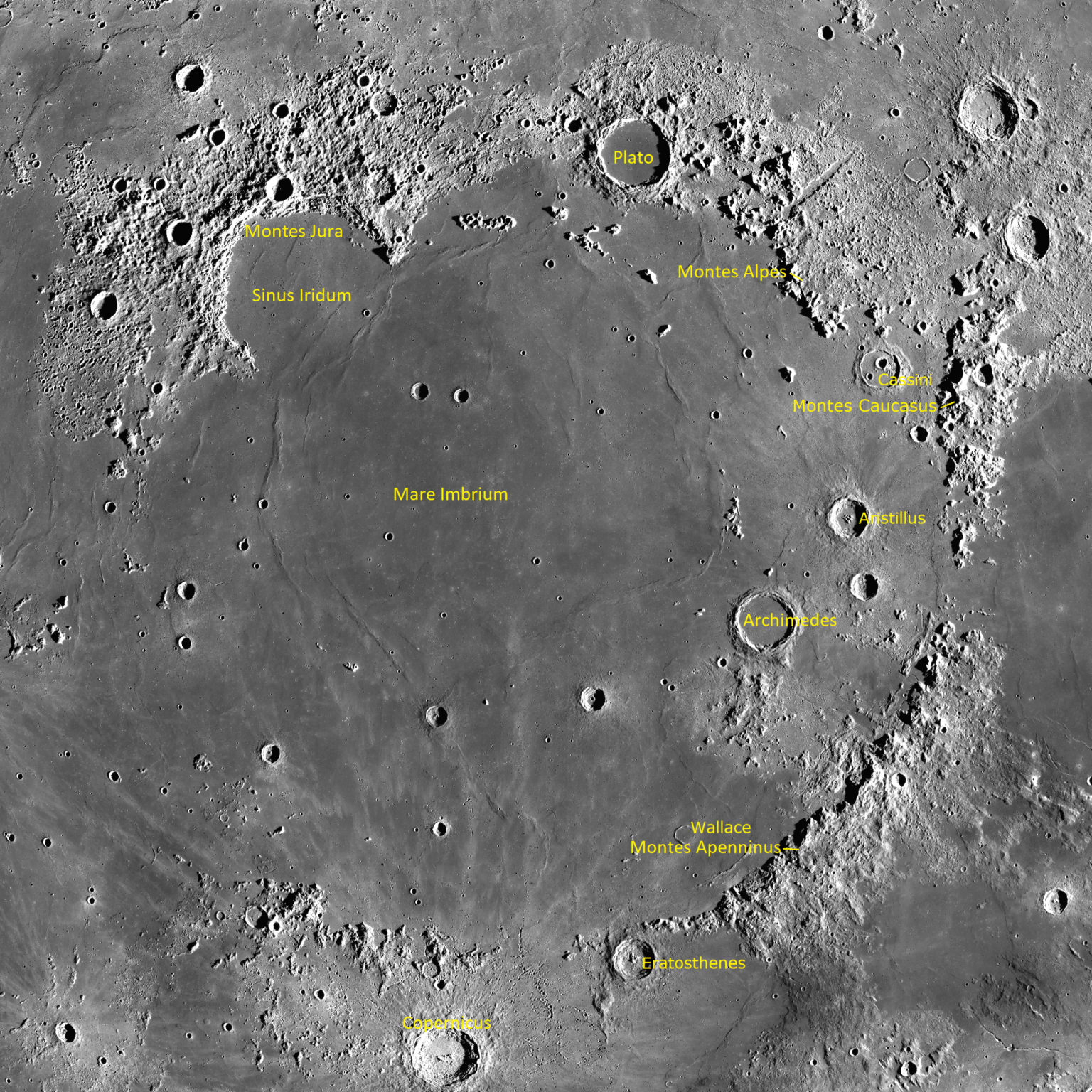
This Lunar Reconnaissance Orbiter image shows the major features of Mare Imbrium “the Sea of Rains”, including its eastern ring of mountain ranges, the dark crater Plato, the “islands” in the north, Archimedes, partially submerged ghost craters, and subtle wrinkles. NASA
Hello, September Stargazers!
Here are your Astronomy Skylights for the week of September 8th, 2024 by Chris Vaughan. Feel free to pass this along to your friends and send me your comments, questions, and suggested topics. You can also follow me on Twitter as @astrogeoguy! Unless otherwise noted, all times are expressed in Eastern Time. To subscribe to these emails please click this MailChimp link.
If you’d like me to bring my Digital Starlab portable inflatable planetarium to your school or other daytime or evening event in Simcoe, Grey, and Bruce Counties, or deliver a virtual session anywhere, contact me through AstroGeo.ca, and we’ll tour the Universe, or the Earth’s interior, together! My book with John A. Read entitled 110 Things to See With a Telescope is a guide to viewing the deep sky objects in the Messier List – for both beginners and seasoned astronomers. DM me to order a signed copy!
The best and easiest sights to enjoy in the evening sky this week will be the waxing moon and Saturn’s yellowish dot. Comet Olbers will be visible below Arcturus after dusk, and all the planets will be observable: Venus after sunset, Saturn and Neptune in evening, and Uranus, Mars, and Jupiter before dawn. Mercury might be glimpsed before sunrise. Read on for your Skylights!
The Moon
We’re at that stage of the lunar month when the moon is in the sky all afternoon and into evening worldwide, making it a convenient object of our attention – even for junior astronomers! The moon is fleeing east, moving it farther away from the evening sun each day. Meanwhile, its Earth-facing hemisphere is filling with light as the pole-to-pole terminator boundary line migrates across its face. On the downside, the moon continues to be straying by nearly its maximum amount below (or celestial south of) the evening ecliptic. That will keep the moon from climbing very high in the sky, and force us to view it through much more atmosphere. That will cause it to “swim” and “dance” under magnification.

The sun is just rising over the moon’s eastern horizon for anyone standing along that curved boundary. Peaks, hills, crests, and crater rims on its sunlit side are casting long, inky black shadows to their west. Deep craters are in full or partial shadow, too. On the dark, unlit side of that line, only the tallest features are catching sunlight, creating small islands of light. Any small telescope will show you those details. Since the angle that the moon makes with the sun is steadily increasing, the terminator is always in motion. The variations in light and dark change from night to night, and even from one hour to the next. Check back regularly!
Today (Sunday) the waxing crescent moon will rise at lunchtime and cross the bright sky. Once the sky darkens, the stars of Libra (the Scales) will appear around it. They’ll all sink into the trees after about 9 pm local time. The moon will rise about 65 minutes later each day and linger longer into evening. Once the sky has darkened on Monday, the stars of Scorpius (the Scorpion) will appear to the left (or celestial east) of the moon. The bright, reddish star Antares, which marks the heart of the scorpion, will shine a palm’s width to the moon’s left. The up-down row of fainter stars that form the claws of the critter will extend upwards through the moon. Observers located in eastern Canada and the northeastern USA can see the moon cross in front of (or occult) the medium-bright claw star Pi Scorpii (aka Fang) through binoculars or a telescope. Near Toronto, the star will shine close to the moon’s lower right. Hours later, on Tuesday evening, observers in a zone west of central Australia and southeastern Indonesia can watch the moon occult Antares. An app like Stellarium can provide the occultation circumstances where you live.

On Tuesday evening in the Americas, the moon will have hopped east to shine to Antares’ left, though it’ll be in next-door Ophiuchus (the Serpent-Bearer). That night, the terminator will fall just to the west of an up-down trio of large, adjoining craters located a short distance south of the moon’s center. Ptolemaeus, Alphonsus, and Arzachel are all large enough to see with binoculars and any size of telescope. 154 km wide Ptolemaeus, the northernmost crater, has been battered by later impacts that confirm its older age. The flat, almost featureless floor has been filled by lava flows, submerging its central peak and elevating its floor. Alphonsus (119 km wide) below it is older yet, and only partially filled, allowing its central peak to remain visible. Alphonsus contains a triangle of dark spots that are most prominent when the moon is full (as it will be next week) – ash deposits from long-ago volcanic venting. Relatively young Arzachel (96 km wide) below Alphonsus has an unaltered floor and a terraced rim. Numerous north-south stripes (or lineations) carved by ejecta blasted out during the powerful Imbrium Basin impact event surround those craters – but those will be easier to see on Wednesday-Thursday.
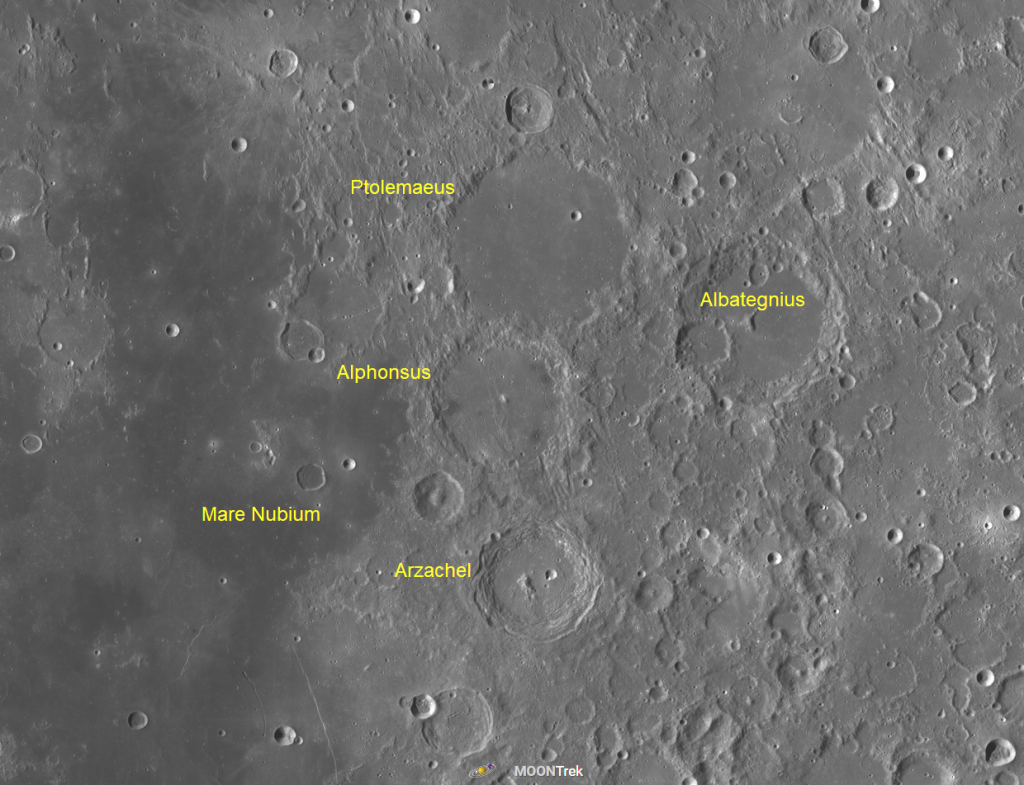
Tuesday night’s moon will appear half-illuminated because it will reach its first quarter phase hours later, on Wednesday morning at 2:06 am EDT or 06:06 Greenwich Mean Time. When the moon completes the first quarter of its journey around Earth, its 90 degree angle away from the sun causes us to see the moon half-illuminated – on its eastern side. The straight line terminator at first and third quarter told ancient astronomers that the moon was a sphere!
When you see the moon on Wednesday evening (or during the late afternoon in a blue sky), it will be gibbous – or more than 50%-illuminated. The moon will be getting pretty bright by then, but you might make out the teapot-shaped stars of Sagittarius (the Archer) sparkling just to the moon’s left (or celestial east). Those stars are more than your outstretched fist across. On Thursday the moon will hop east to shine inside the Teapot.
Friday will be a perfect night to inspect the aforementioned Mare Imbrium in binoculars or your telescope. The terminator will fall just beyond the left-hand (western) rim of “the Sea of Rains”, fully illuminating the dark, circular feature that dominates the northwestern quadrant of the moon’s Earth-facing hemisphere. The mare is the moon’s largest impact basin, measuring more than 1,145 km in diameter. It was formed during the late heavy bombardment period approximately 3.94 billion years ago. Telescope views of Mare Imbrium at this phase will reveal ejecta blankets around its major craters Aristillus and Archimedes, several nearly-submerged ghost craters like Cassini and Wallace, and numerous subtle wrinkle ridges named Heim and Stille.
Another of my favourite moon sights will be highlighted on Saturday and Sunday night. Three prominent craters break up the expanse of Oceanus Procellarum, the widespread dark region on the moon’s left-hand side below Mare Imbrium. Large Copernicus is the easternmost of the craters. Its extensive, ragged ray system intermingles with that of the smaller crater Kepler to its left (lunar southwest). The very bright crater Aristarchus positioned to the upper left (northwest) of them occupies the southeastern corner of a diamond-shaped plateau that is one of the most colorful regions on the moon. NASA orbiters have detected high levels of radioactive radon there. Use a telescope and high magnification to view features like the large, sinuous valley (or rille) named Vallis Schröteri. Its snake-like form begins between Aristarchus and the next-door crater Herodotus and then it meanders across the plateau. It’s stunning!
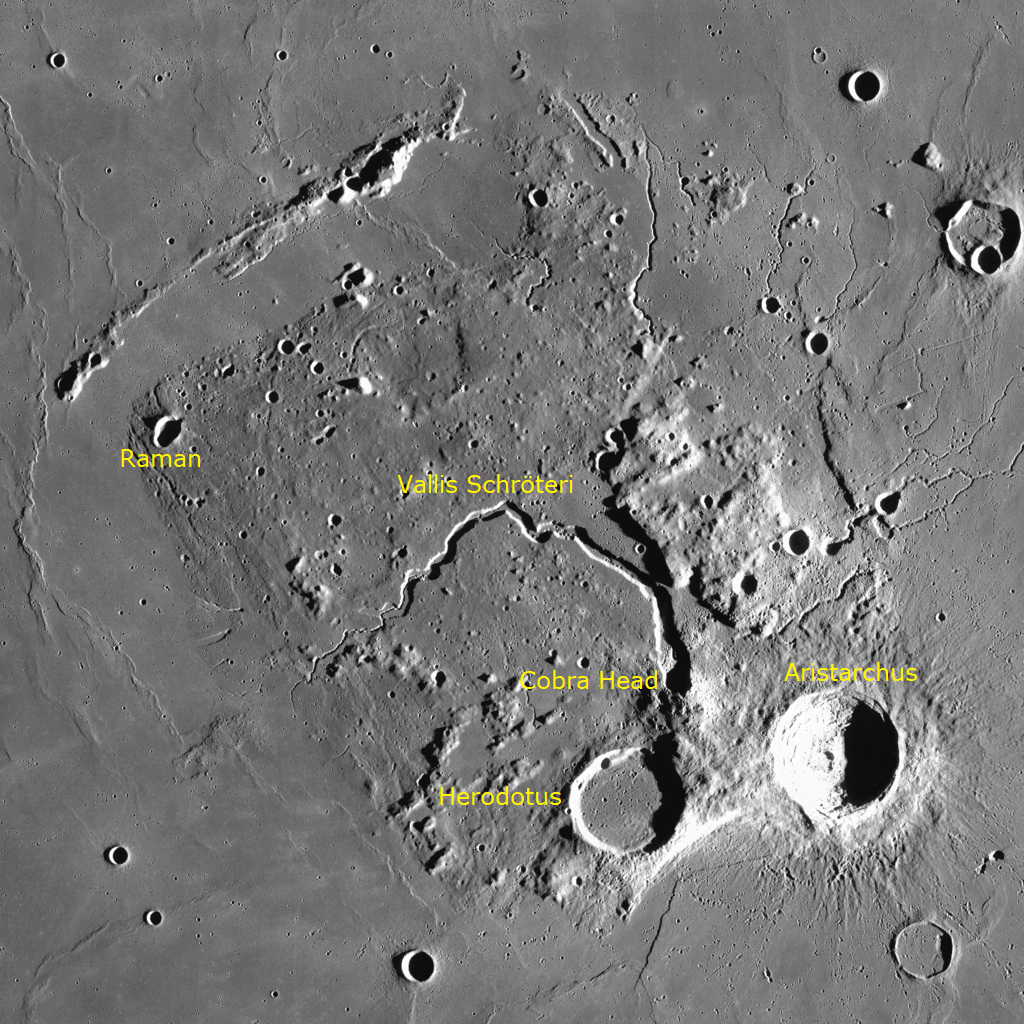
The nearly full moon will rise shortly after dusk on the coming weekend – but the earlier sunsets will give you plenty of time to enjoy views of it. The moon will outshine the faint stars of Capricornus (the Sea-Goat) that surround it. Watch for the prominent dot of Saturn shining off to the moon’s lower left. They’ll cozy up next week.
The Planets
It’s planet-viewing-season nowadays! After sunset you can view Venus, all night long you can see Saturn and notice Neptune, late evening onwards unlocks Uranus, Jupiter joins the party and Mars makes an appearance from the wee hours until sunrise, and you can monitor Mercury at dawn. Let’s get specific…
Brilliant, magnitude 3.85 Venus will be our brilliant “Evening Star”, shining high in the western sky throughout fall and winter. For now, it’s still lurking just above the western horizon after sunset for those of us viewing it from mid-northern latitudes – but it will climb higher as September rolls on. If your western horizon is unobstructed and free of cloud or haze, you can start to look for Venus’ very bright dot starting around 7:45 pm local time. The planet will be the bright, star-like object gleaming less than a fist’s width above the horizon. Wait until the sun has fully set before using binoculars. Folks living closer to the tropics are already seeing Venus gleaming between the palm trees after sunset.
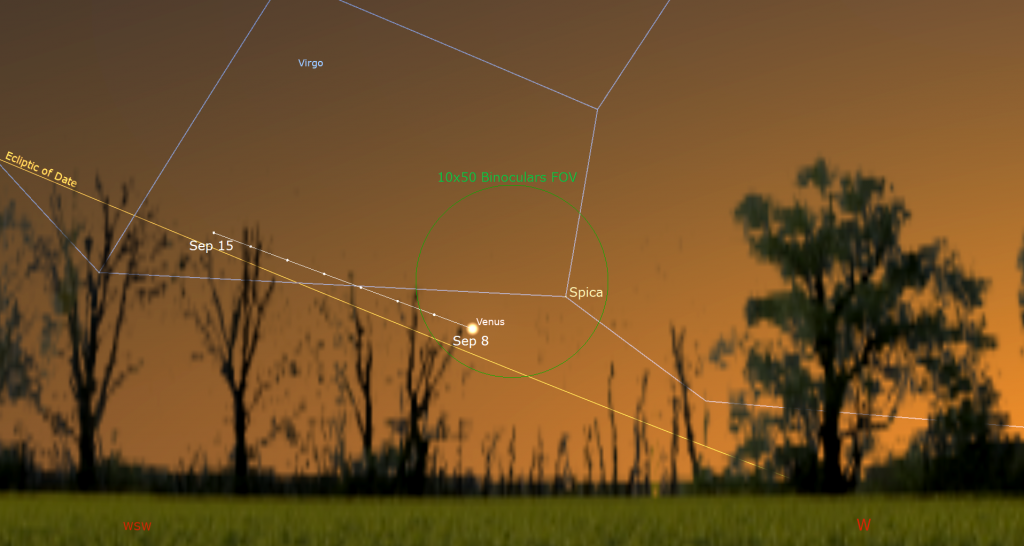
After last night’s opposition, Saturn continues to be the best planet to view this week. The ringed planet will clear the eastern rooftops by about 8:45 pm – but you’ll get the clearest views of Saturn in a telescope when it’s highest in the sky between 10 pm and 4 am. (Thankfully, those times are advancing by half an hour each week.) The faint stars of Aquarius (the Water-Bearer) will be shining just to the right of Saturn. Binoculars will show you a bent-line trio of stars named Psi Aquarii sparkling to Saturn’s lower right. The lower two are white, while the higher one is golden. Two redder stars named Phi and Chi Aquarii will appear to Saturn’s upper and lower right, respectively.
Saturn’s rings will effectively disappear when they become edge-on to Earth next March. They already look like a thick line drawn through the planet’s globe. Good binoculars can hint that Saturn has rings, and any size of telescope will show them, and Saturn’s moons! In most years, Saturn’s moons are spread all around the planet – unlike Jupiter’s Galileans moons, which are always in a line. But Earth’s perspective of the Saturn system this year and next year is making its moons line up with the rings.
Saturn’s largest and brightest moon Titan never wanders more than five times the width of Saturn’s rings from the planet. The much fainter moon named Iapetus “eye-YA-pet-us” can stray up to twelve times the ring width during its 80-day orbit of Saturn. The next brightest moons Rhea “REE-ya”, Dione “Dee-OWN-ee”, Tethys “Teth-EES”, Enceladus “En-SELL-a-dus”, and Mimas “MY-mass” all stay within one ring-width of Saturn. Iapetus has one dark-stained hemisphere and one lighter hemisphere. As the moon switches from the east side to the west of the planet, that dichotomy makes the moon look alternatively brighter and darker. Iapetus’ darker side will face Earth for most of this week.
Titan will move from just to the right of Saturn (or celestial west of it) tonight, pose close above Saturn on Monday, stretch far to Saturn’s lower left (celestial east) on Friday, and then slide back toward Saturn on the coming weekend. (Remember that your telescope will probably flip the view around.) The rest of the moons will be tiny specks in a line beyond the rings. You may be surprised at how many you can see through your telescope if you look closely.
Earth’s perspective of the Saturn system will also cause Saturn’s moons and their small black shadows to frequently cross its disk – but you’ll need a very high quality telescope to watch those. Dione and its tiny shadow will cross Saturn just south of the rings on Friday night from 8:55 pm to 11:51 pm EDT.
Neptune will rise 20 minutes after Saturn and follow it across the sky every night. The distant, blue planet will be spending this year in western Pisces (the Fishes), about 1.3 fist widths to the lower left (or 13° to the celestial ENE) of Saturn. Neptune doesn’t move very quickly through the stars. Neptune will also be located a palm’s width below the circle of stars that forms Pisces’ western fish, and about two finger widths above (or 2° celestial north) of the upright rectangle formed by the medium-bright stars 27, 29, 30, and 33 Piscium. For now, the best time to look at Neptune is while it’s higher up and the sky is dark – between about 10 pm and 5:30 am local time.
Uranus will cross the night sky from 11:30 pm local time, when it rises above the rooftops, to almost dawn. The planet will rise around 10:10 pm this week and climb to high in the couth by morning. In binoculars and a backyard telescope Uranus will appear as a dull, non-twinkling, blue-green star positioned about a palm’s width to the lower right of the bright Pleiades star cluster. The slow-moving, distant planet will remain near that bejeweled patch until 2027! Uranus will be creeping westward in a retrograde loop until the end of January.
If you live at mid-northern latitudes, Jupiter will be rising in the east before midnight, clearing the eastern treetops by about 1 am, and then climbing to catch the eye high, in the southern sky, at sunrise. You’ll be able to see the reddish dot of 16 times fainter Mars shining to the lower left of Jupiter. Mars’ relatively faster orbital motion will increase its separation from Jupiter a little more each morning. Jupiter is between the horns of Taurus (the Bull), about a fist’s width to the left (or 10° to the celestial ENE) of his brightest star, reddish Aldebaran.
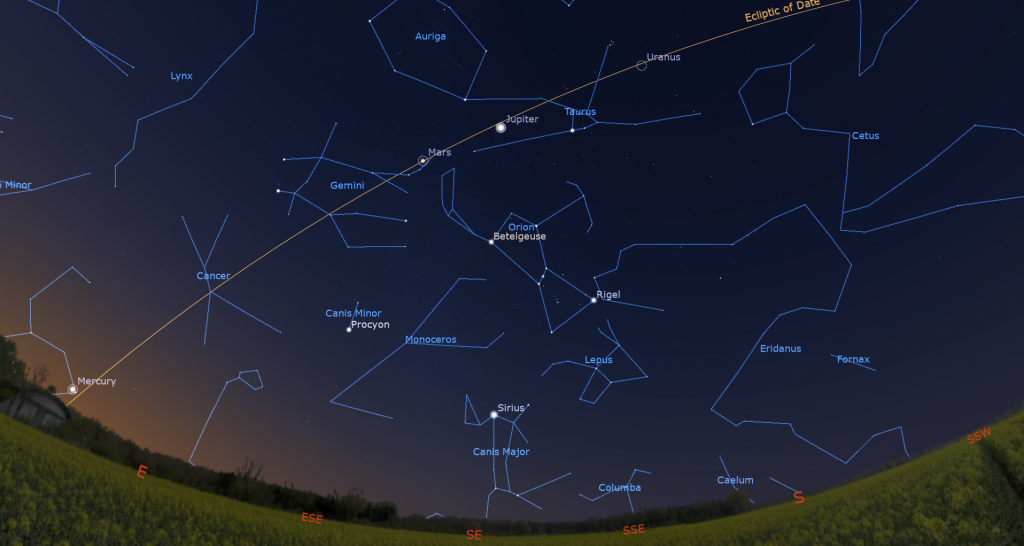
Any binoculars will show Jupiter’s four Galilean moons named Io, Europa, Ganymede, and Callisto lined up beside the planet. Those moons complete orbits of the planet every 1.7, 3.6, 7.2, and 16.7 days, respectively. If you see fewer than four moons, then one or more of them is crossing in front of or behind Jupiter, or hiding in Jupiter’s dark shadow – or two of the moons are very close together, or one moon is eclipsing or occulting another one.
Even a small, but decent quality telescope can show you Jupiter’s dark belts and light zones, which are aligned parallel to its equator. With a better grade of optics, Jupiter’s Great Red Spot, a cyclonic storm that has raged for hundreds of years, becomes visible for several hours when it crosses the planet every 2nd or 3rd night. For observers in the Americas, that GRS will cross Jupiter’s disk in the wee hours of Monday, Thursday, and Saturday, and before dawn on Monday, Wednesday, and Friday morning. If you have any coloured filters or nebula filters for your telescope, try enhancing the spot with them.
From time to time, observers with good quality telescopes can watch the black shadows of the Galilean moons travel across Jupiter’s disk. On Sunday morning, September 15, the black shadow of Europa will travel across Jupiter from 5:20 to 7:45 am EDT (or 09:20 to 11:45 GMT).
Mars will rise about 55 minutes after Jupiter, and fade into the morning daylight before Jupiter does. In a telescope, the red planet will appear as a small, rusty-coloured disk. Its position on the far side of the sun from Earth will keep the planet looking small until later this year. This week, Mars will only be 88%-illuminated because its angle from the sun is 75°. Since last week, Mars has been crossing in front of the faint winter Milky Way. Tonight (Sunday), Mars will pass less than a finger’s width to the lower right (or 0.9 degrees to the celestial south) of the large open star cluster in Gemini named the Shoe-Buckle Cluster, Messier 35, and NGC 2168. The planet and the distant cluster will share the field of view in a backyard telescope from now to Wednesday, and in binoculars from now to September 18. Mars will approach the cluster from the right (celestial west) this week, but your telescope will likely flip and/or mirror the view.
Last up, Mercury will shine above the eastern horizon before sunrise for the first part of this week. Then it will drop too close to the sun to be seen against the glare. You’ll need an unobstructed eastern view that is free of clouds and haze. Mercury will be a bright, unmoving dot a short distance above the horizon. It is safe to use binoculars for your search, but turn them away before the sun rises. On Monday and Tuesday Mercury will shine close to a star named Regulus.
Zodiacal Light Alert
During autumn at mid-northern latitudes every year, the ecliptic extends nearly vertically upward from the eastern horizon before dawn. That geometry favors the appearance of the faint zodiacal light in the eastern sky for about half an hour before dawn on moonless mornings. Zodiacal light is sunlight scattered by interplanetary particles that are concentrated in the plane of the solar system – the same material that produces meteor showers. It is more readily seen in areas free of urban light pollution.
Between now until the full moon on September 17, look for a broad wedge of faint light extending upwards from the eastern horizon and centered on the ecliptic. It will be strongest in the lower third of the sky below the twin stars of Gemini. Don’t confuse the zodiacal light with the Milky Way, which is positioned nearby in the southeastern sky.
Comet Olbers
The moon will brighten the sky this week, but mid-northern latitude observers can still easily find Comet 13P/Olbers in the lower part of the western sky after dusk since it will be passing close to some easy-to-see stars. Large binoculars should show it if you stand in a dark location. Any backyard telescope will show it as a large, greyish fuzzy patch. Watch for a slight greenish tint and the hint of a tail aimed away from the sun. This comet has already passed its peak brightness. Recent brightness estimates have been in the magnitude 8.7 range.
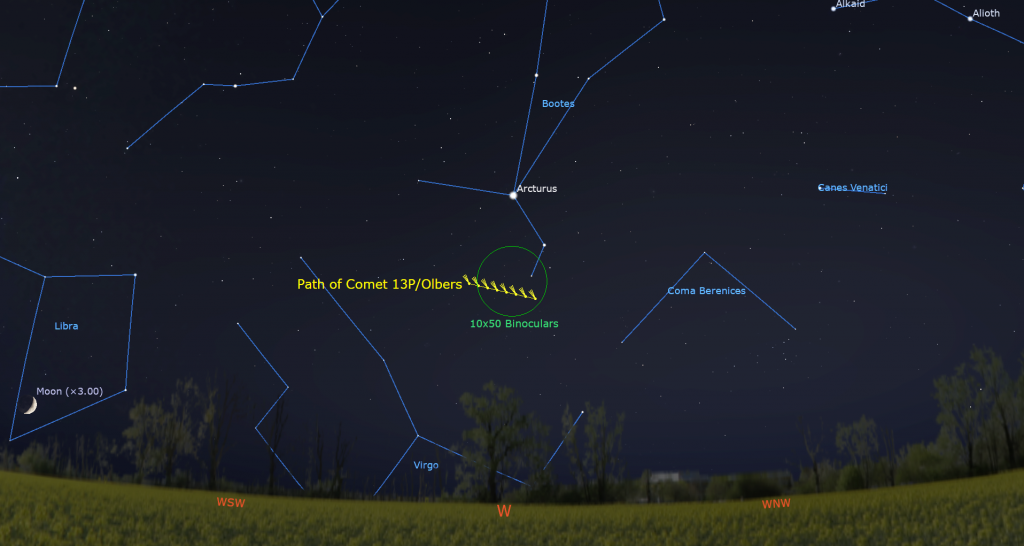
As the sky darkens, face west and look for the brightest star in the lower part of the sky. That’s Arcturus in Boötes (the Herdsman). This week comet 13P/Olbers will be travelling right-to-left (or celestial southeast) below Arcturus. Several finger widths to the lower right of Arcturus you’ll spot the medium-bright star Muphrid that marks the gentleman’s right (western) knee. Binoculars will pick up two fainter stars below Muphrid named Upsilon Boötis (or u Boo) and Tau Boötis (or τ Boo).
Tonight (Sunday) the comet will be positioned a thumb’s width below Upsilon Boötis. In fact, Muphrid, Upsilon, Tau, and the comet will all share the view in binoculars! Every night this week the comet will slide to the left. By next Sunday, the comet will sit about your binoculars’ field width to the left of Upsilon.
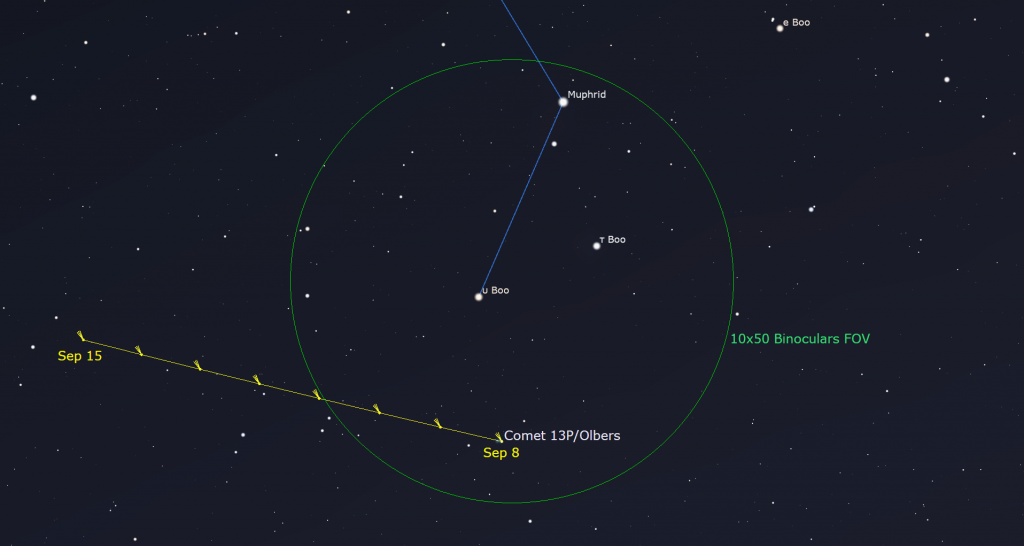
Start your hunt for the comet as soon as the sky gets dark because it will drop too low for decent views by 9:30 pm local time. Note that your telescope will likely flip and/or mirror the view in my chart.
Public Astronomy-Themed Events
Every Monday evening, York University’s Allan I. Carswell Observatory runs an online star party – broadcasting views from four telescopes/cameras, answering viewer questions, and taking requests! Details are here. They host in-person viewing on the first clear Wednesday night each month. Other Wednesdays they stream views online via the observatory YouTube channel. Details are here.
Taking advantage of the crescent moon in the sky this week, the RASC Toronto Centre astronomers will hold their monthly City Sky Star Party in Bayview Village Park (a short walk from the Bayview TTC subway station), starting after dusk on the first clear weeknight this week (Mon, Tue or Thu only). Check here for details, and check the banner on their website home page or Facebook page for the GO or NO-GO decision around 5 pm each day.
On the first clear weeknight this week (September 9-13) the public are invited to Binoculars Stargazing on the lawn at the David Dunlap Observatory. Arrive for this free program at sunset. You’ll learn to use star charts and basic observing techniques, and then use your binoculars to follow a guided tour through the night sky by RASC Toronto Centre astronomers, and stay after the tour to practice your new skills. Please wear / bring appropriate supplies for being outside. Note that there is no building or washroom access during this program. All participants under the age of 16 must be accompanied by an adult. As this program is weather dependent, please visit RASC Toronto’s home page or Facebook page for a GO or NO-GO call.
Keep your eyes on the skies! I love getting questions and requests. Send me some!